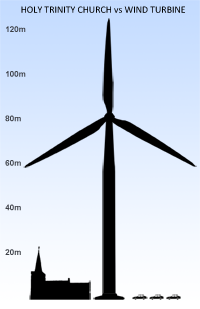- Home
- Proposals
- The Arguments
- About Us
- News
- BBC bias on climate change
- Latest News
- Climate change balance lost by BBC
- Energy Prices-The Times
- Turbines trash landscape benefit billionaires
- Global Warming Panic Over!
- Mini-Nukes the future
- The dirty secret of Britain's power madness
- Extreme weather the new Global Warming
- Tax Payers Alliance Energy view
- Britain can't afford wind power
- Fracking = prosperity?
- Its time to drill- Times leader
- Thoughtful article on Fracking
- Wind double subsidised
- Deluded energy policy
- The EU U-turn over energy
- Windfarm Wars Company in Churchover
- New noise guidance increases risk of harm
- Peter Lilley MP, Delingpole's new hero
- Shale Gas update 2013
- Maggie U-turned on Global Warming
- Devastatingly sad news
- 'smart' energy technology
- Engineers surveyed 2011
- Lord Turnbull speaks out
- Miracle shale gas
- Planning application refused!
- Warwickshire heritage beauty spot protected!
- Press
- Articles
- Letters
- How To Help
- Donations
- Letters of Objection
- New Churchover PC Objection
- New Historic England Objection
- Churchover Resident Objection
- CPRE Objection
- English Heritage Objection
- Objection by expert R&F historian
- Leicestershire County Council objection
- Warwicks CC Ecology objection
- Harborough District Objection
- Churchover PC Objection
- Bitteswell PC Objection
- Pailton PC objection
- Some other Objections sent
- Rugby BC Planning Committee
- Contact Us
22% to 50% Loss of Property Values
http://www.newswire.ca/en/story/1151369/ontario-court-allows-lawsuits-against-wind-company-and-landowners-just-a-matter-of-time
April 23, 2013
Ontario court allows lawsuits against wind company and landowners … just a matter of time
Court Accepts 22% to 50% Loss of Property Values is Occurring Today; Court and Wind Company also Acknowledge Health and Noise Issues in Context of Motion
TORONTO, April 23, 2013 /CNW/ - In a decision released late yesterday, the Ontario Superior Court of Justice has determined that while residents of Clearview Township cannot bring claims for a proposed industrial wind project at this time, the ruling is "without prejudice to the plaintiffs' rights to commence an action for identical or similar relief when and if the Fairview Wind Project receives the necessary approvals to be constructed." [Para. 6]
The court has specifically recognized that claims against wind companies and against landowners who agree to host wind turbines are possible as soon as projects receive approval. [Para. 37] "There are many people who have been waiting to see how the courts would respond to these types of claims" said lawyer Eric Gillespie, whose firm acts for the plaintiffs in the actions. "It now seems clear that as soon as a project is approved residents can start a claim. This appears to be a major step forward for people with concerns about industrial wind projects across Ontario."
In addition, Gillespie's firm acts for other clients in areas where wind projects have been approved. "Dozens of plaintiffs who have already started actions appear to have had the right to bring claims validated" he said. "We can definitely expect more claims now that this door has been opened."
The plaintiffs also filed extensive expert evidence, which was unchallenged by the defendant wind company WPD Canada Limited and landowners. For the purposes of the motion, the defendants took the position that this evidence should be taken as proven and the court adopted this submission. [Para. 8]
After reviewing the evidence of appraiser Ben Lansink, the court states: "(i)n summary, the plaintiffs' evidence shows that they have already suffered harm through a loss in property values and the corresponding interference with the use and enjoyment of their properties." [Para. 9] "The plaintiffs have filed expert appraisal evidence indicating that their properties are likely presently devalued by between 22 to 50 per cent or more, based upon the Proposal as presented." [Para. 31] "… :(I)n this case the court accepts that the plaintiffs have suffered, and are currently suffering, losses culminating in diminished property values …" [Para. 34, emphasis added]
The court also received evidence from Dr. Robert McMurtry, a medical doctor and internationally recognized and published author on the health effects of industrial wind turbines, that in his view: "there is … a high probability that the proposal will cause one or more of the following adverse effects to the plaintiffs` properties: audible noise, low frequency noise, infrasound, visual impact and/or shadow flicker. There is also a high probability that the proposal will cause one or more of the following adverse health effects at the plaintiffs' properties: sleep disturbance, annoyance, headache, tinnitus, ear pressure, dizziness, vertigo, nausea, visual blurring, tachycardia, irritability, problems with concentration and memory, and/or panic episodes."
The court also had evidence from Mr. Richard James, an Institute of Noise Control Engineering (INCE) acoustician, who concluded: "[i]n my professional opinion, the [project] poses a very strong probability almost amounting to a mathematical certainty that the project will … (e)xceed the MOE 40 dBA thresholds for wind turbine noise …"
While the court concluded that since the project design etc. may change there is no way of knowing that these effects will in fact occur [see for example Para. 41], "(t)he fact that a major wind company and a court accepted this kind of evidence as being proven on this motion appears to be unprecedented" said John Wiggins, who together with his wife Sylvia commenced the initial lawsuit. "Government and wind proponents around the world have been denying for many years that turbines devalue properties and cause adverse health effects. To have a multi-national wind company and a court agree that these kinds of problems can be taken as proven elsewhere in the context of this motion, and that a court accepts property losses of 22 to 50% or more are in fact already occurring in Ontario right now, appears to be a real victory."
SOURCE: Cunningham & Gillespie LLP

